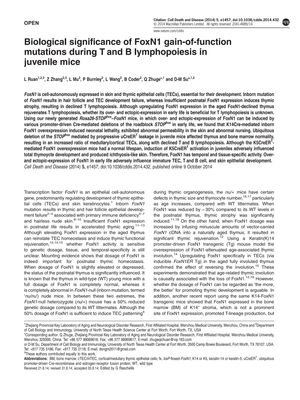TLDR FoxN1 overexpression in young mice harms immune cell and skin development.
The study investigated the effects of over- and ectopic-expression of FoxN1 in juvenile mice using Rosa26 - STOP flox – FoxN1 mice. It was found that K14Cre-mediated inborn FoxN1 overexpression caused neonatal lethality, skin permeability issues, and abnormal nursing. Ubiquitous deletion of the STOP flox in juvenile mice led to thymus and bone marrow abnormalities, increased medullary/cortical TEC ratios, and reduced T and B lymphopoiesis. K5CreER T-mediated FoxN1 overexpression in juveniles resulted in normal lifespan but negatively impacted thymocyte development and caused ichthyosis-like skin. The study concluded that FoxN1's activity is both temporal and tissue-specific, with its over- and ectopic-expression in early life adversely affecting TEC, T and B cell, and skin epithelial development.
22 citations
,
January 2009 in “Advances in experimental medicine and biology” FOXN1 mutations cause severe immunodeficiency, hair loss, nail issues, and thymus defects.
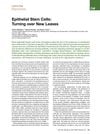 508 citations
,
February 2007 in “Cell”
508 citations
,
February 2007 in “Cell” Epithelial stem cells are crucial for tissue renewal and repair, and understanding them could improve treatments for damage and cancer.
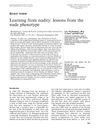 86 citations
,
October 2005 in “Experimental Dermatology”
86 citations
,
October 2005 in “Experimental Dermatology” The Foxn1 gene mutation causes hairlessness and immune system issues, and understanding it could lead to hair growth disorder treatments.
41 citations
,
October 2001 in “Experimental Dermatology” The nude gene is important for skin and hair development.
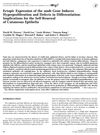 69 citations
,
August 1999 in “Developmental biology”
69 citations
,
August 1999 in “Developmental biology” The nude gene causes skin cell overgrowth and improper development, leading to hair and urinary issues.
May 2014 in “The journal of immunology/The Journal of immunology” Early over-expression of FoxN1 harms immune and skin development.
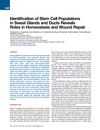 265 citations
,
July 2012 in “Cell”
265 citations
,
July 2012 in “Cell” The study found that sweat glands contain different types of stem cells that help with healing and maintaining healthy skin.
 232 citations
,
January 2013 in “Nature Cell Biology”
232 citations
,
January 2013 in “Nature Cell Biology” Understanding where cancer cells come from helps create better prevention and treatment methods.
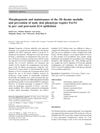 21 citations
,
November 2010 in “Journal of molecular medicine”
21 citations
,
November 2010 in “Journal of molecular medicine” FoxN1 gene is essential for proper thymus structure and preventing hair loss.
 207 citations
,
March 2012 in “Development”
207 citations
,
March 2012 in “Development” Skin needs dermal β-catenin activity for hair growth and skin cell multiplication.
